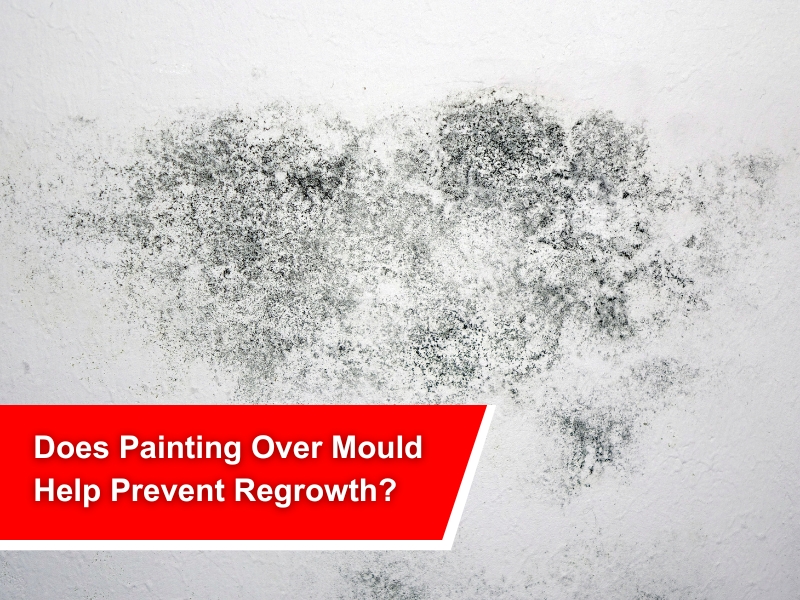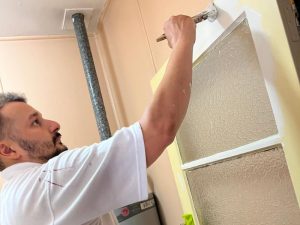Mould growth on walls and ceilings is a common problem in Sydney homes and businesses, especially in damp or poorly ventilated areas. Many people believe painting over mould is a quick fix, but does it prevent regrowth? The short answer is no—unless you properly address the root cause. This article explores the reasons behind mould growth, the effectiveness of painting over it, and the best strategies for long-term prevention.
What causes mould growth on walls and ceilings?
Mould thrives in damp and humid environments. If left untreated, it can damage surfaces and pose health risks. Common causes include:
- Poor ventilation – Bathrooms, kitchens, and basements with inadequate airflow trap moisture, creating the perfect conditions for mould.
- Leaks and water damage – Roof leaks, plumbing issues, or flooding can cause damp walls and ceilings, encouraging mould growth.
- High humidity – Sydney’s coastal climate contributes to humidity levels that often lead to mould problems.
- Condensation – Temperature differences between indoor and outdoor air can cause condensation, leading to wall moisture buildup.
- Absorbent surfaces – Porous materials like plaster, gyprock, and untreated timber can hold moisture, providing a breeding ground for mould.
Understanding the health effects of mould exposure is crucial, as prolonged exposure can lead to respiratory issues, allergies, and other health complications.
Can painting over mould solve the problem?
Painting over mould might cover stains temporarily, but it doesn’t eliminate the issue. In fact, it can make things worse by trapping moisture beneath the paint. Here’s why this approach is ineffective:
- Mould will continue to grow – If the underlying moisture problem isn’t fixed, mould will spread beneath the paint, causing bubbles and peeling.
- Health risks remain – Mould releases spores into the air, leading to respiratory issues, allergies, and irritation. Simply covering it with paint doesn’t remove these hazards.
- Short-lived results – Without proper treatment, mould will resurface, requiring more maintenance and potentially damaging the surface further.
What are the proper steps to prepare surfaces before painting?
To ensure a long-lasting, mould-free finish, proper preparation is essential. Professional painters follow these steps:
- Identify and fix the source of moisture – Address leaks, improve ventilation, and use dehumidifiers to reduce humidity.
- Clean the affected area – Use a mould-killing solution (such as diluted bleach or a commercial mould remover) to eliminate spores. For a flawless and long-lasting paint job, following essential wall cleaning tips for a smooth paint finish ensures that surfaces are free from dirt, grease, and other contaminants that could affect paint adhesion.
- Dry the surface completely – Ensure walls and ceilings are fully dry before applying any treatments.
- Apply a mould-resistant primer – This creates a protective barrier and prevents mould from penetrating the paint.
- Use high-quality mould-resistant paint – Specialised paints help to inhibit future growth.
- Ensure proper ventilation – Keeping air moving during and after painting helps prevent moisture buildup.
Preparing your home for an interior paint job involves more than just picking the right colours; it requires careful attention to surface preparation to ensure a smooth, long-lasting finish.
Which types of paint help prevent mould regrowth?
Using the right type of paint is crucial in mould prevention. Some effective options include:
- Mould-resistant paints – Formulated with antimicrobial properties, these paints slow down mould growth in humid areas.
- Acrylic paints with mildew inhibitors – These paints offer better moisture resistance compared to standard water-based paints.
- Oil-based paints – While less common, oil-based paints provide a durable barrier against moisture. However, they have stronger fumes and longer drying times.
- Low-VOC paints – Safer for indoor air quality, these paints reduce harmful emissions while still offering protection against mould.
How can professional painters ensure a long-lasting finish?
Hiring professionals ensures that mould-prone surfaces are treated correctly for long-term results. By opting for professional residential painting, skilled painters use high-quality materials and expert techniques to ensure a smooth, durable finish that stands the test of time. Here’s how experts achieve a durable, mould-free finish:
- Comprehensive assessment – Identifying the root cause of mould and recommending effective solutions.
- Proper surface preparation – Cleaning, drying, and priming surfaces before applying paint.
- High-quality materials – Using premium mould-resistant primers and paints that provide lasting protection.
- Expert application techniques – Ensuring even coverage and proper adhesion for a flawless finish.
- Post-painting recommendations – Providing advice on ventilation and maintenance to prevent mould recurrence.
How can you maintain a mould-free home or business after painting?
Even with the best painting techniques, ongoing maintenance prevents mould regrowth. Here are some effective strategies:
- Improve ventilation – Use exhaust fans in bathrooms and kitchens to reduce humidity.
- Control indoor humidity – Keep indoor humidity levels below 60% using dehumidifiers or air conditioners.
- Fix leaks promptly – Address any plumbing or roofing leaks immediately.
- Clean regularly – Wipe down surfaces prone to moisture, such as bathroom walls, with a mild disinfectant.
- Use moisture-resistant materials – Consider using waterproof coatings in areas with high humidity.
Is hiring a professional worth it for mould-related painting projects?
While DIY solutions might seem cost-effective, hiring a professional painter for mould-prone areas has significant advantages:
- Expertise in identifying and treating mould sources – Professionals don’t just cover up mould; they address the root cause.
- Use of high-quality, mould-resistant products – Ensuring long-lasting results.
- Proper safety measures – Preventing exposure to harmful mould spores during cleaning and painting.
- Efficient and professional results – Saving time and avoiding costly mistakes.
- Warranty and aftercare support – Professionals often guarantee their work, giving you peace of mind.
Get expert help from Mi Painting & Maintenance
At Mi Painting & Maintenance, we don’t just paint over mould—we solve the problem at its source. Our team of experienced painters and plasterers ensures a high-quality finish that stands the test of time. We’ve transformed homes and commercial spaces across Sydney, taking on even the toughest painting challenges. Clients have praised our attention to detail and ability to tackle difficult projects, even those that haven’t been painted in decades.
We use top-tier, mould-resistant paints, thorough preparation methods, and industry-leading techniques to provide a finish that not only looks great but also helps prevent future mould issues. Whether you need interior or exterior painting, our expert team delivers outstanding results at a fair price.
Ready to refresh your space? Schedule a consultation with Mi Painting & Maintenance, and let us bring new life to your home or business.
Frequently Asked Questions
-
How do I know if I have mould or just stains on my walls?
Mould often appears as black, green, or brown patches with a fuzzy texture. On the other hand, stains do not spread and typically do not have a musty odour.
-
Can I use any paint over mould-resistant primer?
While mould-resistant primer helps, using high-quality anti-mould paint provides better long-term protection.
-
Does mould-resistant paint prevent mould forever?
No paint can permanently prevent mould. However, when combined with proper moisture control, mould-resistant paints help slow down its regrowth.
-
What is the best way to prevent mould in a bathroom?
Use a good exhaust fan, keep surfaces dry, and choose moisture-resistant, anti-mould paint.
-
How often should I repaint mould-prone areas?
It depends on the environment, but high-humidity spaces may require repainting every 3-5 years with mould-resistant paint.
-
Can mould damage walls permanently?
Yes, long-term mould growth can weaken surfaces, leading to costly structural repairs.
-
Are there natural ways to prevent mould?
Yes, using vinegar, baking soda, or tea tree oil can help clean and prevent mild cases of mould.
-
Should I repaint my ceiling if I see water stains?
Water stains may indicate leaks, which should be fixed before repainting to prevent mould growth.
-
Can a dehumidifier help with mould prevention?
Yes, dehumidifiers help maintain indoor humidity levels below 50%, reducing the likelihood of mould growth.
-
What should I do if mould keeps returning despite painting?
Recurrent mould indicates an underlying moisture issue. Professional inspection and repair may be necessary to address the root cause.



